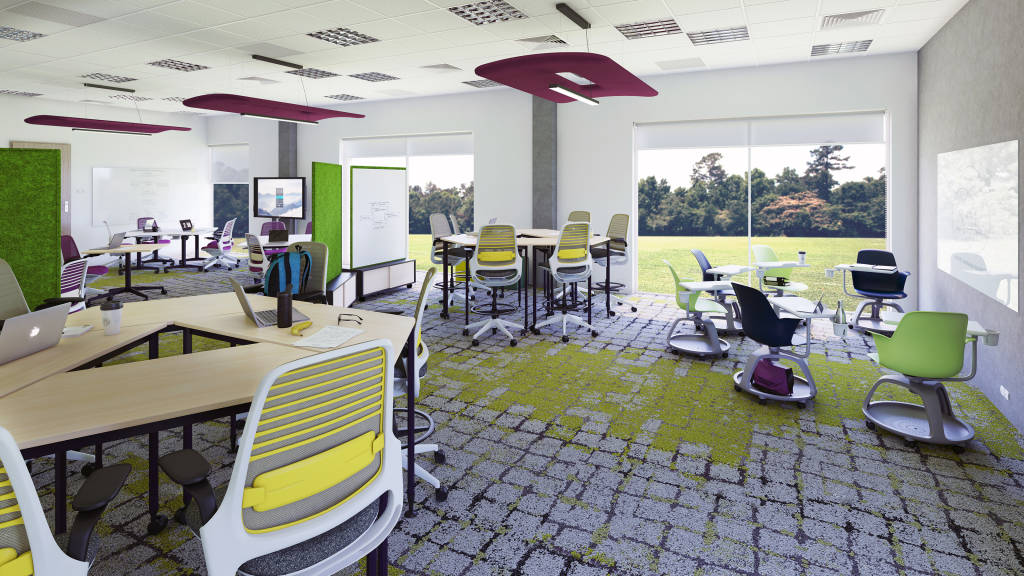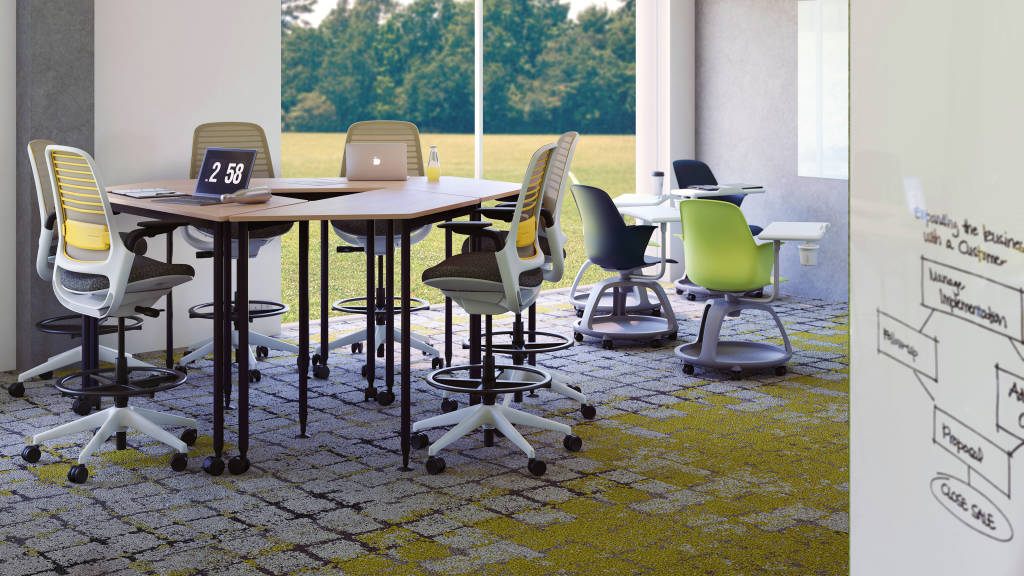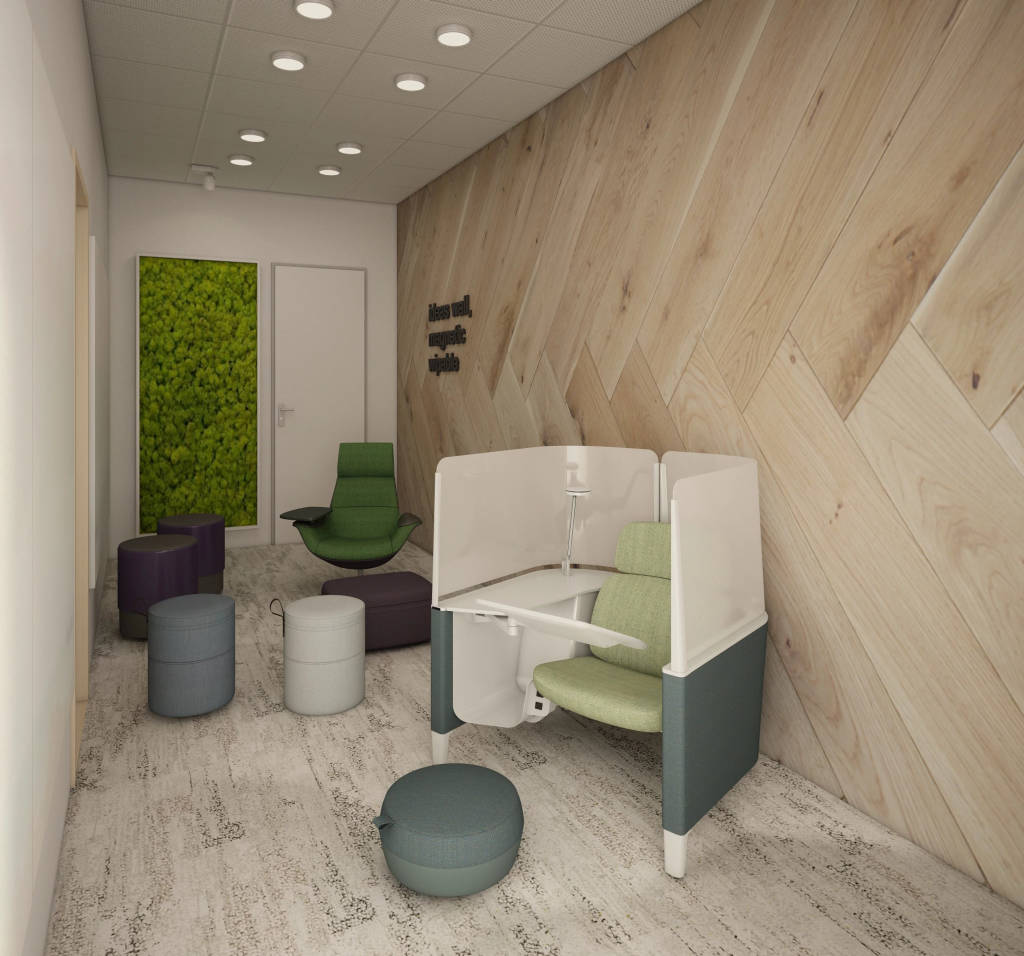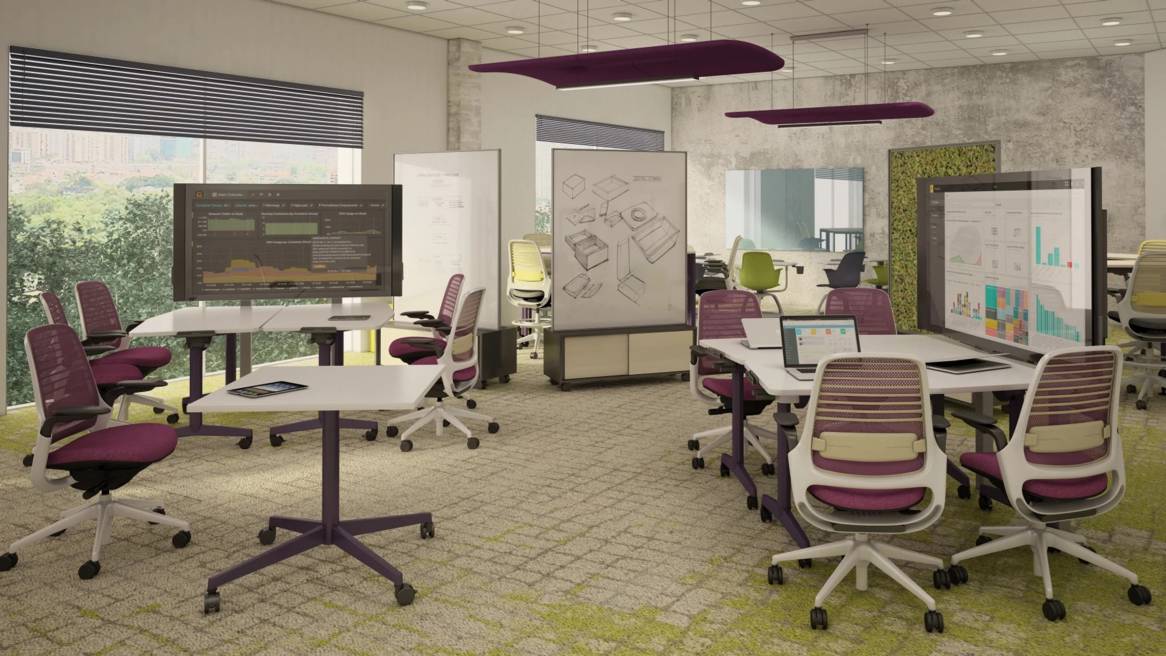Cranfield’s Active Learning Centre
A place to think “outside of the box”
Cranfield University
Cranfield University is a British postgraduate and research-based public university specialising in science, engineering, technology and management. The roots in aerospace can be seen as Cranfield is the only university in Europe with a fully operational airport at the centre of the campus. The academic disciplines work closely together, blending as they do in the commercial world to deliver solutions. The Cranfield campus is approximately 50 miles (80 km) north of Central London and adjacent to the village of Cranfield.
Peter Harrison
Peter Harrison is the head of the Centre for Andragogy (adult education) and Academic Skills. He leads a multi-disciplinary team of academic and professional staff who provide a university-wide focus on research into andragogy, specialising in postgraduate and executive academic and professional skills. Steelcase talked with Peter to learn how integrating Steelcase research, insights and furniture helped enhance creative learning at Cranfield and find out how the university is adapting in the face of the global Coronavirus pandemic.
The Project
Harrison and his team wanted to refresh the classrooms in their new building in Bedfordshire. A nurturing ground for great ideas in the aeronautics industry, they wanted to inspire students and teachers to think differently. “I wanted something that says to you ‘this is different – I am going to have to behave differently – this is fun, safe, non-threatening – this is not too comfortable,’ not somewhere to hide away for an easy time,” says Harrison.
The objective was to break the limits of the traditional lecture classroom and take learning to a new dimension. The space needed to be multi-functional, supporting creativity, collaboration, critical thinking and communication. They imagined an innovation room that would help them innovate faster and more successfully.
Before
Instead of the large, tiered lecture halls that most students and clients associate with universities, Cranfield mainly consists of rooms with flat floors and traditional fixed layouts. The classrooms in the Centre for Andragogy were no different. Before the transformation, the spaces lacked diversity in setting typology. The technology was placed in one central point in the room, making it hard for all students to see and interact with the screen easily. Behaviour in the classroom was limited to a few activities with little room for flexibility, and the furniture offered no support for a range of postures.
Harrison and his team connected with Steelcase to learn more about the research the company had conducted on active learning and saw how Steelcase insights and furniture could transform their spaces. After learning about the unique needs of the students and professors at Cranfield, the Steelcase Education team and the team from dealer Hunts developed a design to leverage movement and enhance creativity.
“We started exploring rooms and pedagogy styles to support a large palette of activities and learning modes. We decided that the best approach, given the amount of technology in the room, was a blended-learning environment where students start from the same point but travel through their ideas at different speeds or phases,” says Georgeta Macovei, sales consultant for Steelcase Education.
After

 Products: Verb FlipTop Table, Series 1, Verb table (special trapezoid shape), Node Chair with Tablet, PolyVision Whiteboard, Verb Whiteboard
Products: Verb FlipTop Table, Series 1, Verb table (special trapezoid shape), Node Chair with Tablet, PolyVision Whiteboard, Verb Whiteboard
Steelcase created a new learning space with easily reconfigurable furniture that supports different work modes, such as ideation, brainstorming, synthesizing, prototyping and sharing. The environment supports 30–50 people who can work in various group sizes simultaneously, at different speeds, using vertical whiteboards and touch screens. In collaboration with the dealer Hunts, the space’s acoustic performance was improved with acoustic wall coverings, soft furnishings, bespoke acoustic units that facilitate writing, storage and an acoustic carpet.
The designer from Hunts defined the mood board according to current biophilic trends, providing valuable insights from the market in order to connect the Steelcase concept to an attractive modern classroom of the future. They used their experience in designing top spaces, to provide a 360 alignement of the spaces, and thus ensure the success of the space. Russell Emmett from dealer Hunts, oversaw the delivery of the project and the continuation of our collaboration with Cranfield University.
The new space is flexible in terms of layout and re-use, encouraging active reconfiguration of furniture during an activity. The technology is there when needed, but analog tools also support the ideation process, fulfilling one of the team’s goals — to not be completely dependent on technology. Faculty and students have found the classrooms inspirational and saw a distinct shift in behaviour. The new classrooms foster a culture of sharing, with people using the rooms when needed versus staking a permanent claim.

Throughout the project, the design team saw new potential in a storage room with an excellent view outside. Harrison and his team were reluctant in the beginning to convert the space, but Steelcase Education put forward a convincing design to renovate it into a Think area — designed for time to think through ideas, focus or process information from a collaborative session alone. Now that the room is installed, Harrison says that many people, including himself, like to use the space for focused time and wished it was their personal office.
“This room is exactly the type of space you think about when you imagine a forward thinking, innovative and entrepreneurial University. It is a separate and safe space to encourage collaboration and thinking “outside of the box”. The opportunity to engage with my colleagues in a team meeting, in a fun and hands on way, really helped to get the creative ideas running. The flexibility of the room means it would be my go to place for any other meetings that require innovative outputs.” says the PSU staff.
Adapting to the Coronavirus
Cranfield’s Response to Corona in Numbers
March 1, 2020
- Total teaching capacity: 6,057
- Capacity of largest tiered lecture hall: 250
- Campus hours: 9 am–6 pm
September 1, 2020 (UK Covid safe layout)
- Total teaching capacity: 3,068
- Capacity of largest tiered lecture hall: 34
- Campus hours: 7 am–8 pm
Q&A with Peter Harrison
360: How did Cranfield adapt to the Coronavirus?
PH: In response to the crisis, the main Cranfield campus closed to almost all staff and students on March 21, 2020. During the lockdown period, no face-to-face teaching took place, but a number of programmes continued online. Some of these were blended-learning programmes that simply increased the amount of time spent online whereas others were physical programmes that rapidly pivoted to online learning via Zoom. Many assessments were also redesigned from timed, closed-book exams to non-timed or extended open-book exams.
A key feature of Cranfield programmes is the combination of team and individual activity, which culminates in presentations. This year we held online conferences where multiple teams presented their work over a period of one or two days using either Zoom or Microsoft Teams. The examiners and industrial experts were in the virtual audience and had separate, private meeting space in the conferences.
360: How will you teach in the future? Will you use blended learning, if yes, to what extent?
PH: The university has committed to a minimum mix of 70:30 face-to-face and online learning for the majority of MSc programmes. This ratio is higher for a limited number of management and leadership programmes. A timetable was constructed to achieve this, but many variables will come into play, and some of them will be beyond our immediate control.
360: How will space support the new learning experience?
PH: The space as it existed in March 2020 cannot support the adapted learning experience. As a result, there has been a massive change on campus with teaching and research having absolute priority. Staff who are not directly student-facing will not return to campus until 2021 and will continue to work from home except for very specific activities. The large circulation and open-plan office areas were repurposed as teaching spaces. These teaching areas are likely to remain until at least Easter 2021.
One of the concerns is the tension between literal flexibility, i.e., repositioning furniture at will in a variety of spaces, versus the requirements of maintaining a COVID-safe environment. Currently, almost 800 chairs have been removed from circulation and social areas to reinforce spacing and ease traffic flow.
Tiered lecture halls have seen the greatest effect. What was once an efficient way to maximise occupancy has become a very inefficient use of space and possibly a poor student experience. There must be two empty seats between students, and students can only sit in every other row. This has massively affected big venues as rows of 30 seats with no centre aisle sit completely empty.
Creativity in the face of COVID-19
Like many universities, Cranfield has faced teaching challenges due to the Coronavirus, and while students may be learning more from home or third-spaces in the coming months, the reimagined Steelcase classrooms in the Centre for Andragogy and Academic Skills welcome those who come to campus to a collaborative environment designed for the creativity and innovation needed for the future.


